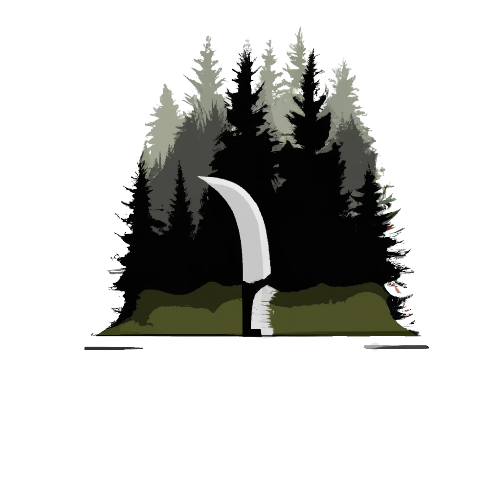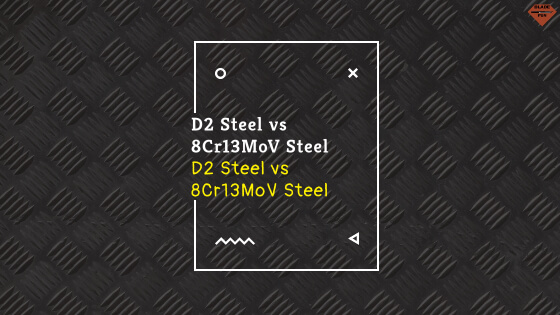D2 and 8Cr13MoV (and 8Cr13MoV’s slightly better brother, 8Cr14MoV) are all pretty good knife steels for their price points. That’s generally where the similarities end, though.
Here’s the short version:
D2 is a higher-end steel compared to 8Cr13MoV. If you’re looking for a higher-end, sharper knife, go with D2. If you want a cheap knife you can beat up, go for 8Cr13MoV. D2 tends to have more edge retention and hardness compared to 8Cr13MoV, but is more expensive and less corrosion resistant.
There’s a lot more that goes into it than just that, though, and each has more properties than just that. Let’s check all those out.
D2 Steel
D2 is generally going to be a higher-end steel compared to 8Cr13MoV. It’s usually a low- to mid-tier steel.
D2 has about 1.5-2% carbon, which means it’s got a higher edge retention and hardness, but because of that, it’s harder to sharpen. Those tend to balance each other out, though: You don’t have to sharpen D2 very often, but when you do, it’s going to be harder to sharpen than 8Cr13MoV.
Sometimes, though, D2 can be more brittle and can chip and break when you’re doing tough activities on it like chopping wood. But that’s only a sometimes problem. This sometimes problem can be caused by shoddy steel or too much pressure when sharpening the knife, which can cause microchips in the steel you can’t see. This usually will lead to bigger chipping you can see when you use it on more strenuous activities.
Generally, it’s going to be tough enough to withstand a beating like, say, chopping down a tree. But, if you aren’t chopping down a tree (and I’m going to assume/hope that you aren’t with a knife–use a chainsaw or axe), you’ll be fine.
Another difference between the two is corrosion resistance. D2 is technically not a stainless steel. It doesn’t quite reach the chromium requirements to be considered corrosion resistant, which means that it’s going to more easily rust compared to 8Cr13MoV.
So, if you’re going to be in a more humid environment with D2, you’re probably going to need to coat it with mineral oil from time to time to keep it from rusting. Or, you can go with a different blade steel. Spyderco’s Salt series, for instance, handles very well in humid environments.
Those are all generalities, though. Some D2 can differ depending on where it’s made, how it’s heat treated, how it’s maintained, the blade geometry and edge angle, and more. It’s usually a safe bet that if it’s made or handled in the U.S. or Europe that you won’t have those problems. D2 from China could have these problems, though.
Basically, D2 holds an edge longer and tends to be stronger, but rusts easier. Where the steel comes from can also affect the steel properties. If you get a D2 knife from the U.S. or Europe and maintain the blade with mineral oil, it’s a safe bet that you can get around those issues.
8Cr13MoV
8Cr13MoV (and 8Cr14MoV) is a budget steel. The seemingly cryptic name of the steel actually refers to its composition. The 8 refers to the percentage of carbon (0.8%), the Cr13 refers to the percentage of chromium (about 13%), the Mo refers to molybdenum, and the V refers to vanadium. In 8Cr14MoV, the Cr14 means that it has a slightly higher composition of chromium and is thus more corrosion resistant.
All those components each do different things: The carbon increases strength (it’s important to note that at high levels, carbon leads to brittleness, which means easy chipping and breaking), the chromium increases corrosion resistance, the molybdenum increases hardenability (which basically means that it’s easier to harden, and thus manufacture), and vanadium improves wear resistance and strength.
8Cr13MoV and 8Cr14MoV are going to be more corrosion resistant than D2, but don’t hold an edge as well because they’re softer steels. The fact that they’re softer steels also means that they’re easier to sharpen.
The softer steel also means that it’s going to be better for things like chopping wood… Well, comparatively, anyway. It’s much less likely to chip and break, but it will probably roll and bend. So, you’ll still have a knife blade by the end of it, it’ll just be deformed (probably very deformed). With D2, you might not have a blade left by the end of chopping wood if it’s really brittle (which can be a problem with D2).
Unlike D2, 8Cr13MoV is pretty much exclusively made in China. So, you’re unlikely to find a “high-end” 8Cr13MoV. And in case you’re wondering, 8Cr14MoV
And again, things like how it’s heat treated, the edge geometry, and where it comes from will all affect how strong the steel is and how well it performs. However, since it’s such a cheap blade steel, it’s probably not that much to worry about. A company that often uses 8Cr13MoV (and uses it very well) is Kershaw.
Basically, 8Cr13MoV is going to be on budget knives that you shouldn’t feel bad about beating up or getting lost. It’s for beater knives that you’ll probably get for $35 or less.
Knife Recommendations
Now that you know the differences between D2 and 8Cr13MoV (and 8Cr14MoV), here are some of my recommendations for knives with those blade steels.
If you just want general knife companies to look at, then I’d recommend checking out SOG, Kershaw, and CRKT. They’re all good knife companies and you’ll be able to find a variety of knives with D2, 8Cr13MoV, and 8Cr14MoV steels from them.
Here are some of my favorites with 8Cr13MoV/8Cr14MoV and D2 steel:
Kershaw CQC Series – 8Cr13MoV/8Cr14MoV
Kershaw has a series of really cool knives called their CQC series. They’ve got the Emerson Wave on them, which is a little hook on the knife blade that causes it to catch on your pants pocket and open as soon as you pull it from your pocket. It’s pretty cool.
They’ve all either got 8Cr13MoV steel or 8Cr14MoV steel. The price depends on which one you get, but they’re generally all pretty cheap. They all also function the same, they just have different blade profiles and handle shapes. If you’re looking for a cool, budget-friendly knife, check out the Kershaw CQC series. My favorite of the bunch is the Kershaw CQC-11K.
CRKT Pilar II – D2
The CRKT Pilar II is an all around solid knife. It’s got a modified sheepsfoot, a flipper, G10 handle scales, a frame lock, and D2 steel. While it doesn’t have the flashy features of other knives like the Emerson Wave or assisted opening, it’s just a nice, reliable, solid knife.
The D2 steel makes it a slightly more expensive knife than the Kershaw CQC series, but it’s going to last longer and hold an edge longer than those knives because of the D2 steel. Overall, if you’re looking for an all-around solid knife, get this one.
SOG Flash AT – D2
The SOG Flash AT is not only a solid knife, but it’s got some flashy features and just looks good.
It’s got D2 steel, assisted opening, a spine-mounted lock, and an XR lock. It also comes in a couple different colors: Urban grey, civic cyan, and garnet red. It’s also got partially serrated versions and straight edge versions of each color.
If you’re looking for a knife that looks good, functions well, and has some flashy features, you’ll enjoy the SOG Flash AT.
Well, there you go. You’ve got the differences between D2 steel and 8Cr13MoV (and 8Cr14MoV) and some awesome knives that use all of those knife steels.

